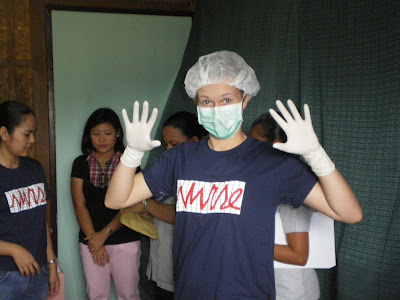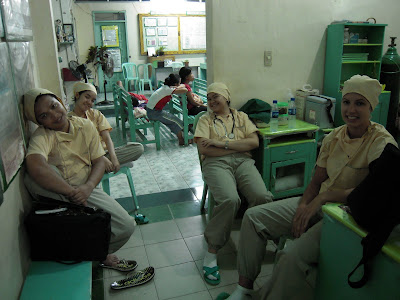
On our last day of clinical we participated in a mass immunization for a measles outbreak occurring in Mayamot Elementary School.
This was followed by a culminating activity to sum up our experiences of the past month. Here we were able to share many of our personal experiences and stories with the Filipino nursing students and faculty. The Dean’s of nursing from St. Paul’s University, University of the

Philippines, and University of East Ramon were all able to speak to us in regards to the global partnership being built between our schools and their hopes to continue this relationship for years to come. Lorna Butler, the University of Saskatchewan’s Dean of Nursing, was at hand to voice our desire to maintain a strong bond in the future. As nursing students, we feel this experience has impacted how we will practice in the future and therefore strongly believe in maintaining this partnership for the benefit of future NEPS students.
As this experience marked our last day in clinical, the time has finally come to close our blog. The past six weeks have offered ample learning opportunities in regards to community health care delivery within the Philippines. It also provided us with the chance to grasp a greater understanding and appreciation of the Filipino culture. Not only did we learn a lot about a very unique and interesting population, but we also learned a lot about ourselves along the way. One of the most valuable lessons we will take away from this experience is learning how to work effectively as a team. Considering we spent a lot of “quality” time together throughout the past month we learned quickly the importance of becoming a functional team member. Knowing how to work effectively as a team member is a valuable quality to have as a nurse and we feel this experience has aided us in developing this quality.
 We would now like to take this opportunity to thank all of those who helped facilitate our time in the Philippines. These include, but are not limited to, the Dean’s of nursing Dr. J. Tuazon, UPM, Dr. C. Divinagracia, UERMMMC, and Sr. Carolina Agravante, SPC, President, St. Paul Univeristy, Iloilo, all of whom welcomed us into their schools whole heartedly. Also, the many faculty members who helped us receive an extraordinary clinical experience, including Jerry, Ruby, Mrs. Lim, Ms. Castro, Ms. Mollo, and Zandro. You were all amazing and taught us so much, thanks! We would like to extend another huge thank you to all of the nursing students who acted as our “buddies” and our personal translators while working in the community. We have formed new and lasting friendships and are looking forward to maintaining these contacts in the future. Thanks goes out to Lorna Butler from the University of Saskatchewan, who helped make this trip possible, as well as our instructor Susan Fowler-Kerry who believed in us enough to allow us to partake in this experience. Lastly, thank you to all of those who followed our blog and took interest in sharing our experiences. We bid you adieu.
We would now like to take this opportunity to thank all of those who helped facilitate our time in the Philippines. These include, but are not limited to, the Dean’s of nursing Dr. J. Tuazon, UPM, Dr. C. Divinagracia, UERMMMC, and Sr. Carolina Agravante, SPC, President, St. Paul Univeristy, Iloilo, all of whom welcomed us into their schools whole heartedly. Also, the many faculty members who helped us receive an extraordinary clinical experience, including Jerry, Ruby, Mrs. Lim, Ms. Castro, Ms. Mollo, and Zandro. You were all amazing and taught us so much, thanks! We would like to extend another huge thank you to all of the nursing students who acted as our “buddies” and our personal translators while working in the community. We have formed new and lasting friendships and are looking forward to maintaining these contacts in the future. Thanks goes out to Lorna Butler from the University of Saskatchewan, who helped make this trip possible, as well as our instructor Susan Fowler-Kerry who believed in us enough to allow us to partake in this experience. Lastly, thank you to all of those who followed our blog and took interest in sharing our experiences. We bid you adieu.Top picture: Ashley and Melissa preparing syringes with the measles vaccine.
Middle picture: Nursing student performing the Filipino Tinikling dance.
Bottom picture: (top-bottom, left-right) Bethel, Ashley, Sr. Carolina Agravante, Dr. C. Divinagracia, Lorna Butler, Dr. J. Tuazon, Kirsten, Ms. Molo, Mrs. Lim, Ruby, Chelsea, Melissa, Joelle, Whitney and Jessica












